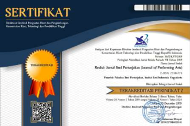Penciptaan Konserto Etude Tangganada Pentatonik untuk Pembelajaran Violin dan Orkestra
Abstract
The Creation of Pentatonic Scale Etude Concerto for Violin and Orchestral Learning. This research aims to explain creating a musical work in the form of a violin etude in the form of a concerto. The concerto is arranged in a free pentatonic scale from traditional Javanese idioms: the lancaran and gangsaran rhythm. The concerto consists of one movement that contains etude material, namely learning the technique of playing the violin in a beautiful and exciting melody. The problem highlighted is students' difficulty learning etude for the violin, which is often considered complicated. In the learning process, students tend to be oriented towards violin music such as concertos, sonatas, or musical pieces (short works) compared to etude works. Therefore, it is important for creating the concerto etude to bridge the students' violin learning process, both for educative and performative dimensions. Creating the etude concerto in this traditional idiom is expected to foster student interest in learning to practice etude. The research was organized in several stages: document collection, observation, artistic, trial, and dissemination. The research/design method was taken from Reginald Smith Brindle (1986), i.e., Musical Composition and King Palmer Teach Yourself to Composed Music (1952). The method is as follows: listening to different music that is close to the research topic to find ideas, using the violin and piano to make melodic pieces, including double, triple, four-stop techniques, connecting, combining, developing synchronized melody pieces, rhythmic variations, rhythms, articulation variations, syncopations, rhythm figures, melodic decorations, harmonies, dynamic variations, and so on. The conclusion of the research on creating a concerto with one movement is more freedom to express ideas. The use of lancaran and gangsaran rhythms in a pentatonic scale to give the nuances of the Central Java region, turns out to be more nuanced with a Mandarin concerto. After being implemented, it turns out that this concerto is still quite difficult for learning violin 3.
Keywords
Full Text:
PDFReferences
Adler, S. (2002). The Study of Orchestration. In WW Norton & Company, Inc., Copyright.
Brindle, R. S. (1986). Musical composition. Oxford University Press.
Cole, W. (1979). The Form of Music. The Associated Board of the Royal School of Music.
de Fretes, D., Pramuditya, P., Lundito, F. J., & Kusumaningrum, M. R. M. (n.d.). Pemetaan Teknik Double-Stops Pada Violin Concerto No. 2 Anatoly Komarowsky. Grenek: Jurnal Seni Musik, 10(2), 81–91.
Dewi, M. O. R. (2016). Analisis Teknik Komposisi Musik “Variation on Theme of Sepasang Mata Bola” Karya Jazeed Djamin. Resital: Jurnal Seni Pertunjukan (Journal of Performing Arts), 17(2), 98–117.
Irawati, Eli. (2019). Transmission of Kelentangan Music Among the Dayak Benuaq of East Kalimantan in Indonesia. Malaysian Journal of Music, 8 (1), 108-121. https://doi.org/10.37134/mjm.vol8.7.2019
Irawati, Eli. (2021). The Transmission of Resilience Learning in the Context of Formal Education an Ethnomusicological Review. Linguistics and Culture Review, 5 (S3), 1040-1053. https://doi.org/10.21744/lingcure.v5nS3.1664
Indrawan, A. (2015). Adaptasi Konserto pada Ensambel Gitar sebagai Upaya Pengayaan Bahan Ajar Matakuliah Ensambel. Resital: Jurnal Seni Pertunjukan, 16(2), 95–103. https://doi.org/10.24821/resital.v16i2.1509
Kaestri, V. Y. (2021). Perancangan Aransemen Lagu Suwe Ora Jamu dan Cublak-Cublak Suweng Ditinjau dari Perspektif Ilmu Harmoni Dasar. Resital: Jurnal Seni Pertunjukan (Journal of Performing Arts), 22(1), 36–47.
Keller. (2016). Program Notes of the Oklahoma City Philharmonic: “The Butterfly Lovers Concerto for Violin and Orchestra (Violin Concerto Liang Shanbo dan Zhu Yingtai), karya Chen Gang, dan He Zhan Hao.
Machlis, J. (1963). The Enjoyment of Music: An Introduction to Perspective Listening. W.W. Norton & Company Inc.
Mack, D. (1995). Sejarah Musik Jilid 3 (I). Pusat Musik Liturgi.
McNeill, R. J. (1998). Sejarah Musik 1. PT BPK Gunung Mulia.
Palmer, K. (1952). Teach Yourself to Compose Music. English Universities Press.
Sadie, S. (2002). The New Grove Dictionary of Music and Musicians. London: Macmillan.
Stein, L. (1962). Structure and style: the study and analysis of musical forms. Summy-Birchard Company.
Westrup, J. A., Harrison, F. L., & Wilson, C. (1976). Collins Encyclopedia of Music. Harper Collins Publishers.
DOI: https://doi.org/10.24821/resital.v22i3.6736
Refbacks
- There are currently no refbacks.
This work is licensed under a Creative Commons Attribution 4.0 International License.



